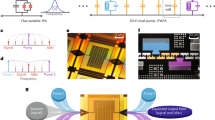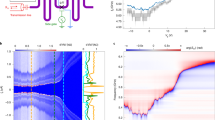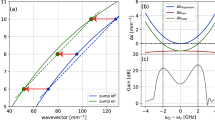Abstract
High-fidelity qubit measurement is a critical element of all quantum computing architectures. In superconducting systems, qubits are typically measured by probing a readout resonator with a weak microwave tone that must be amplified before reaching the room-temperature electronics. Superconducting parametric amplifiers have been widely adopted as the first amplifier in the chain, primarily because of their low-noise performance, approaching the quantum limit. However, they require isolators and circulators to route signals up the measurement chain and to protect qubits from amplified noise. Although these commercial components are wideband and simple to use, their intrinsic loss, size and magnetic shielding requirements impact the overall measurement efficiency and scalability. Here we report a parametric amplifier that achieves both broadband forward amplification and backward isolation in a single, compact, non-magnetic circuit that could be integrated on chip with superconducting qubits. The approach relies on a nonlinear transmission line that supports the travelling-wave parametric amplification of forward propagating signals and isolation via the frequency conversion of backward propagating signals. This travelling-wave parametric amplifier and converter has the potential to reduce the readout hardware overhead when scaling up the size of superconducting quantum computers.
This is a preview of subscription content, access via your institution
Access options
Access Nature and 54 other Nature Portfolio journals
Get Nature+, our best-value online-access subscription
$32.99 / 30 days
cancel any time
Subscribe to this journal
Receive 12 digital issues and online access to articles
$119.00 per year
only $9.92 per issue
Buy this article
- Purchase on SpringerLink
- Instant access to full article PDF
Prices may be subject to local taxes which are calculated during checkout




Similar content being viewed by others
Data availability
The data that support the findings of this study are available from the NIST Public Data Repository at https://doi.org/10.18434/mds2-3875 (ref. 35). Source data are provided with this paper.
Code availability
The codes used for the simulations are available from the corresponding authors on reasonable request.
References
Blais, A., Grimsmo, A. L., Girvin, S. & Wallraff, A. Circuit quantum electrodynamics. Rev. Mod. Phys. 93, 025005 (2021).
Wang, Z. et al. Cavity attenuators for superconducting qubits. Phys. Rev. Appl. 11, 014031 (2019).
Caves, C. M. Quantum limits on noise in linear amplifiers. Phys. Rev. D 26, 1817 (1982).
Aumentado, J. Superconducting parametric amplifiers: the state of the art in Josephson parametric amplifiers. IEEE Microw. Mag. 21, 45–59 (2020).
Arute, F. et al. Quantum supremacy using a programmable superconducting processor. Nature 574, 505–510 (2019).
Kamal, A., Clarke, J. & Devoret, M. H. Noiseless non-reciprocity in a parametric active device. Nat. Phys. 7, 311–315 (2011).
Metelmann, A. & Clerk, A. A. Nonreciprocal photon transmission and amplification via reservoir engineering. Phys. Rev. X 5, 021025 (2015).
Ranzani, L. & Aumentado, J. Circulators at the quantum limit: recent realizations of quantum-limited superconducting circulators and related approaches. IEEE Microw. Mag. 20, 112–122 (2019).
Sliwa, K. M. et al. Reconfigurable Josephson circulator/directional amplifier. Phys. Rev. X 5, 041020 (2015).
Lecocq, F. et al. Nonreciprocal microwave signal processing with a field-programmable Josephson amplifier. Phys. Rev. Appl. 7, 024028 (2017).
Chapman, B. J. et al. Widely tunable on-chip microwave circulator for superconducting quantum circuits. Phys. Rev. X 7, 041043 (2017).
Abdo, B. et al. Josephson directional amplifier for quantum measurement of superconducting circuits. Phys. Rev. Lett. 112, 167701 (2014).
Lecocq, F. et al. Efficient qubit measurement with a nonreciprocal microwave amplifier. Phys. Rev. Lett. 126, 020502 (2021).
Rosenthal, E. I. et al. Efficient and low-backaction quantum measurement using a chip-scale detector. Phys. Rev. Lett. 126, 090503 (2021).
Esposito, M., Ranadive, A., Planat, L. & Roch, N. Perspective on traveling wave microwave parametric amplifiers. Appl. Phys. Lett. 119, 120501 (2021).
Macklin, C. et al. A near–quantum-limited Josephson traveling-wave parametric amplifier. Science 350, 307–310 (2015).
Planat, L. et al. Photonic-crystal Josephson traveling-wave parametric amplifier. Phys. Rev. X 10, 021021 (2020).
Malnou, M. et al. Three-wave mixing kinetic inductance traveling-wave amplifier with near-quantum-limited noise performance. PRX Quantum 2, 010302 (2021).
Ranzani, L. et al. Wideband isolation by frequency conversion in a Josephson-junction transmission line. Phys. Rev. Appl. 8, 054035 (2017).
Malnou, M., Larson, T. F. Q., Teufel, J. D., Lecocq, F. & Aumentado, J. Low-noise cryogenic microwave amplifier characterization with a calibrated noise source. Rev. Sci. Instrum. 95, 034703 (2024).
Ho Eom, B., Day, P. K., LeDuc, H. G. & Zmuidzinas, J. A wideband, low-noise superconducting amplifier with high dynamic range. Nat. Phys. 8, 623–627 (2012).
WRspice circuit simulator. Whiteley Research http://www.wrcad.com/wrspice.html (accessed 1 May 2024).
Gaydamachenko, V., Kissling, C., Dolata, R. & Zorin, A. B. Numerical analysis of a three-wave-mixing Josephson traveling-wave parametric amplifier with engineered dispersion loadings. J. Appl. Phys. 132, 154401 (2022).
Kissling, C. et al. Vulnerability to parameter spread in Josephson traveling-wave parametric amplifiers. IEEE Trans. Appl.Supercond. 33, 1–6 (2023).
Engin, A. et al. Time-domain modeling of lossy substrates with constant loss tangent. In Proc. 8th IEEE Workshop on Signal Propagation on Interconnects 151–154 (IEEE, 2004).
Kern, S. et al. Reflection-enhanced gain in traveling-wave parametric amplifiers. Phys. Rev. B 107, 174520 (2023).
Chaudhuri, S., Gao, J. & Irwin, K. Simulation and analysis of superconducting traveling-wave parametric amplifiers. IEEE Trans. Appl. Supercond. 25, 1–5 (2015).
Chaudhuri, S. et al. Broadband parametric amplifiers based on nonlinear kinetic inductance artificial transmission lines. Appl. Phys. Lett. 110, 152601 (2017).
Spietz, L., Lehnert, K. W., Siddiqi, I. & Schoelkopf, R. J. Primary electronic thermometry using the shot noise of a tunnel junction. Science 300, 1929–1932 (2003).
Spietz, L., Schoelkopf, R. J. & Pari, P. Shot noise thermometry down to 10mk. Appl. Phys. Lett 89, 183123 (2006).
Howe, L. et al. Compact superconducting kinetic inductance traveling wave parametric amplifiers with on-chip RF components. IEEE Trans. Appl. Supercond. 35, 1701107 (2025).
Lecocq, F. et al. Microwave measurement beyond the quantum limit with a nonreciprocal amplifier. Phys. Rev. Appl. 13, 044005 (2020).
Gaydamachenko, V., Kissling, C. & Grünhaupt, L. rf-SQUID-based traveling-wave parametric amplifier with input saturation power of −84 dBm across more than one octave in bandwidth. Phys. Rev. Appl. 23, 064053 (2025).
Ranadive, A. et al. Kerr reversal in Josephson meta-material and traveling wave parametric amplification. Nat. Commun. 13, 1737 (2022).
Malnou, M. Data for nature electronics manuscript, ‘a traveling-wave parametric amplifier and converter’. NIST Public Data Repository https://doi.org/10.18434/mds2-3875 (2025).
Acknowledgements
We thank R. Kaufman, C. Denney, A. Ranadive, N. Roch, M. Praquin and P. Campagne-Ibarcq for fruitful discussions. We thank M. Castellanos-Beltran and C. Scarborough for their feedback on the paper. Certain commercial materials and equipment are identified in this paper to foster understanding. Such identification does not imply recommendation or endorsement by the National Institute of Standards and Technology, nor does it imply that the materials or equipment identified is necessarily the best available for the purpose.
Author information
Authors and Affiliations
Contributions
M.M., J.D.T., J.A. and F.L. conceived and designed the experiment. M.M. designed and simulated the device. B.T.M. and J.A.E. designed the packaging. M.M. performed the measurements. M.M. and F.L. analysed the data. K.G. and K.C. fabricated the device. M.M., B.T.M., J.D.T., J.A. and F.L. wrote the paper.
Corresponding authors
Ethics declarations
Competing interests
The authors declare no competing interests.
Peer review
Peer review information
Nature Electronics thanks the anonymous reviewers for their contribution to the peer review of this work.
Additional information
Publisher’s note Springer Nature remains neutral with regard to jurisdictional claims in published maps and institutional affiliations.
Extended data
Extended Data Fig. 1 False color scanning-electron microscope picture of one TWPAC supercell.
The color coding is identical to that of Fig. 1: the Josephson junctions are colored in brown, the capacitors to ground are colored in green, and the resonators to ground are colored in purple.
Extended Data Fig. 2 The gain and isolation of the TWPAC, when either the PA pump (a) or the FC pump (b) is turned on.
The TWPAC biasing parameters are similar to that of Fig. 3b: Id = 1 μA, ωa/2π = 14.52 GHz, Pa = − 75 dBm, ωc/2π = 3.15 GHz and Pc = − 80 dBm (at the chip inputs).
Extended Data Fig. 3 The full two-port scattering parameters of the TWPAC, in the frequency window where we observe both PA and FC.
The TWPAC biasing parameters are similar to that of Fig. 3b. The input (a) and output (b) reflections of the through cable (black) and of the TWPAC (green) with the FC conversion pump turned on are plotted as a function of frequency. (c) The transmission as a function of frequency is the same as presented in Fig. 3b. (d) The input reflection without (dashed line) and with (plain line) the FC pump turned on.
Extended Data Fig. 4 The TWPAC saturation power, focusing on the frequency window where we observed both PA and FC.
(a) The TWPAC gain as small VNA probe tone power is shown as a function of frequency with (blue) and without (yellow) the FC pump turned on. Here, it is calculated as the ratio of the transmission when the dc bias and the pumps are turned on, to the transmission when the dc bias and the pumps are turned off. (b) The TWPAC-input 1 dB compression point is shown with (blue) and without (yellow) the FC pump turned on. The cut portion around 8.8 GHz corresponds to a situation where P1dB was not yet reached at the highest VNA probe tone power.
Extended Data Fig. 5 The evolution of the TWPAC output spectrum, measured on the SA, when increasing a CW probe tone at 7 GHz.
(a) The output spectrum at low probe tone power presents 5 major peaks at ωc, \({\omega }_{{c}_{2}}=2{\omega }_{c}\), ωs, ωi = ωa − ωs, and ωa − 2ωc. We cut the spectrum at the first TWPAC stopband, because within the stopband the gain of the chain cannot be accurately measured, therefore the power of any bin within the stopband cannot be accurately compared to the other bins. (b) The output spectrum when sending a probe tone power P1dB = − 86 dBm contains more peaks, that correspond to activating more parametric processes. (c) The output power of the few selected modes, referred to the TWPAC output is plotted as a function of the input probe tone power, referred to the TWPAC input. The vertical line indicates P1dB for the CW tone at ωs = 7 GHz. The input probe tone power calibration was the same as in the Methods, sec. C1, and we refer the output power to the TWPAC output by dividing the power measured on the SA by the chain’s gain, measured with the SNTJ, with the TWPAC off.
Extended Data Fig. 6 Effect of the FC pump on the gain and added noise.
(a) The on/off gain (that is, not referenced to a through) as a function of frequency, when the FC pump is off (yellow) and when it is on (blue). (b) The added noise is plotted within the same frequency range, when the FC pump is off (yellow) and when it is on (blue). (c) The added noise of the bin centered at 7 GHz is plotted as a function of the TWPAC gain, when the FC pump is off (yellow) and when it is on (blue). The black line represents the model Nsys = N1 + N2/G.
Supplementary information
Supplementary Information
Supplementary Sections 1–5, Tables 1–4 and Figs. 1–4.
Supplementary Data
Source data for Supplementary Figs. 1–4.
Source data
Source Data Fig. 2
Source data for Fig. 2.
Source Data Fig. 3
Source data for Fig. 3.
Source Data Fig. 4
Source data for Fig. 4.
Source Data Extended Data Fig. 1
Source data for Extended Data Fig. 1.
Source Data Extended Data Fig. 2
Source data for Extended Data Fig. 2.
Source Data Extended Data Fig. 3
Source data for Extended Data Fig. 3.
Source Data Extended Data Fig. 4
Source data for Extended Data Fig. 4.
Source Data Extended Data Fig. 5
Source data for Extended Data Fig. 5.
Rights and permissions
About this article
Cite this article
Malnou, M., Miller, B.T., Estrada, J.A. et al. A travelling-wave parametric amplifier and converter. Nat Electron (2025). https://doi.org/10.1038/s41928-025-01445-8
Received:
Accepted:
Published:
DOI: https://doi.org/10.1038/s41928-025-01445-8



